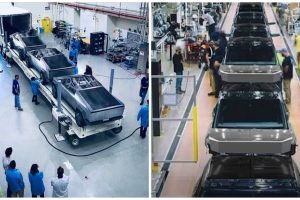- 🚗 A Tesla owner in Missouri uses a Cybertruck to tow a construction trailer and saves nearly $65 per day on fuel costs.
- 🔋 The savings come from charging the vehicle at home during off-peak hours at a rate of 4.5 cents per kWh.
- 📉 The owner’s previous vehicle, a Dodge Ram, used premium fuel and achieved only 9 mpg, resulting in higher fuel costs.
- 💰 Estimated annual savings from using the Cybertruck could reach up to $16,900.
- 🏗️ The owner’s business needs align with the Cybertruck’s capabilities, highlighting potential benefits for other small businesses with similar operations.
- 🚛 Cybertruck’s suitability for short to medium-distance towing makes it an attractive option for other businesses.
In the realm of transportation and logistics, innovative solutions often pave the way for significant advancements in cost-efficiency and environmental sustainability. One such transformative solution is the Tesla Cybertruck, an all-electric vehicle that has recently demonstrated its remarkable potential in the towing industry. A Tesla owner from Missouri has become a testament to the Cybertruck’s prowess, revealing substantial daily and annual savings from using this electric pickup to tow a construction trailer.
The Game Changer: Switching from Gas to Electric
The narrative begins with a Missouri-based contractor who swapped his fuel-guzzling Dodge Ram for a Tesla Cybertruck as the primary vehicle for towing his construction trailer. The implications of this switch are profound, predominantly because of the economic benefits.
From $70 to Virtually Zero: Daily Savings Explained
- The Iceberg of Fuel Costs: The contractor previously spent about $70 per day fueling his Dodge Ram. With a fuel efficiency of just 9 miles per gallon, the costs quickly added up, primarily due to the use of premium fuel necessitated by towing-specific modifications.
- The Cybertruck Effect: By transitioning to the Cybertruck, the owner slashed these expenses significantly. The key? Charging the vehicle at home during off-peak hours at a mere 4.5 cents per kWh, enabling an impressive saving of approximately $65 daily.
- Annualized Benefits: If you extrapolate these savings over the course of a typical work year (around 260 days), the potential annual savings soar to $16,900. This figure highlights the efficacy of electric vehicles in reducing operational costs.
Disruptive Technology Meets Practical Application
The Cybertruck not only makes economic sense but also demonstrates a broad capacity for practical business applications. Here are a few ways it showcases its versatility:
Suitability for Business Operations
- Meeting Business Needs: The Cybertruck’s robust towing capabilities align seamlessly with many small to medium-sized businesses that require reliable and efficient towing solutions.
- Design and Capability: Built for both efficiency and power, the Cybertruck is ideal for short to medium-distance towing, making it a viable option for enterprises engaged in logistics, construction, and other sectors requiring dependable transport means.
Environmental Impact
- Reducing Carbon Footprint: The reduction in fuel consumption directly translates into lower carbon emissions, contributing to environmentally sustainable practices.
- Incentive for Adoption of EVs: This case study could serve as a catalyst for other businesses to explore and adopt electric vehicles, driving forward the green transition in commercial operations.
The Broader Implications for the Industry
The experiences of this Tesla owner hint at a trend that could redefine vehicle use in commercial settings. With Tesla’s ongoing innovations and the increasing availability of electric vehicle infrastructure, businesses are better positioned to capitalize on the cost savings and environmental benefits offered by EVs like the Cybertruck.
Key Considerations for Potential Transition
- Cost-Benefit Analysis: Potential adopters should weigh the upfront costs of acquiring an electric vehicle against the cumulative fuel savings and lower maintenance costs over time.
- Operational Fit: Evaluate the daily logistical requirements to ensure that the electric vehicle’s range and towing capabilities align with business needs.
- Infrastructure Readiness: Assess whether the necessary charging infrastructure is available or can be feasibly developed to support the transition.
Conclusion
The Tesla Cybertruck stands as a beacon of what the future of transportation could look like—economically efficient, environmentally friendly, and seamlessly integrated into the business landscape. For those willing to adopt and adapt, the rewards can be both substantial and transformative.





